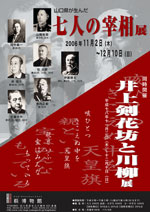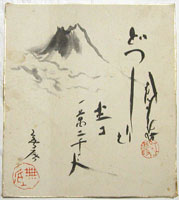| The Seven Prime Ministers |
Hirobumi Ito (1841〜1909) |
| Patriot in the last days of the Tokugawa shogunate, and politician and senior statesperson in the Meiji period.He learned at Shokasonjuku school and went to Britain illegally to study.After returning to Japan he was earnestly engaged in overthrowing the Tokugawa shogunate.In the new Meiji government he held some important posts and drafted the Meiji Constitution. He became Japan’s first prime minister to guide Japan into a modern nation in the formative years.He formed the cabinet four times. |
|
Aritomo Yamagata (1838〜1922) |
| Patriot in the last days of the Tokugawa shogunate, and politician and army general in the Meiji and Taisho periods.He was a student of Yoshida and a key figure in the movement to overthrow the shogunate.He is credited with laying the foundation of Japan’s modern military.He twice served as prime minister. |
|
Taro Katsura (1847〜1913) |
| Army general and politician in the Meiji period.He learned at the domain school.He played an active role in the Boshin war.He became prime minister three times from the Meiji period to the Taisho period.He made efforts to conclude a few important treaties such as the Anglo-Japanese alliance and the annexation of Korea. |
|
Masatake Terauchi (1852〜1919) |
| Army general and politician.He served as army minister in the first Katsura cabinet during the Russo-Japanese war and remained in the post through several cabinets.He was appointed the first governor general of Korea and directed its annexation by Japan. |
|
Giichi Tanaka (1864〜1929) |
| Military man and politician in the Meiji, Taisho and Showa periods.During the Sino-Japanese war, he served under Yamagata Aritomo in Manchuria.Distinguished Hagi native Giichi Tanaka eventually went on to hold the posts of minister of army and president of the political party Seiyukai.He became prime minister in 1927. |
|
Nobusuke Kishi (1896〜1987) |
| Bureaucrat and politician in the Showa period.As prime minister he promoted revision of the United States-Japan Security Treaty for the purpose of restoring independent diplomacy for Japan and cementing close relations with the United States.He formed the cabinet twice.He was an elder brother of Eisaku Sato.He won the United Nations peace prize. |
|
Eisaku Sato (1901〜1975) |
| Politician in the Showa period.He became prime minister and set the record for the longest continuous tenure in Japan.He counted among his diplomatic accomplishments the normalization of relations with South Korea and the reversion of Okinawa from the United States to Japanese administration.He was awarded a Nobel prize for peace in 1974. |
|

